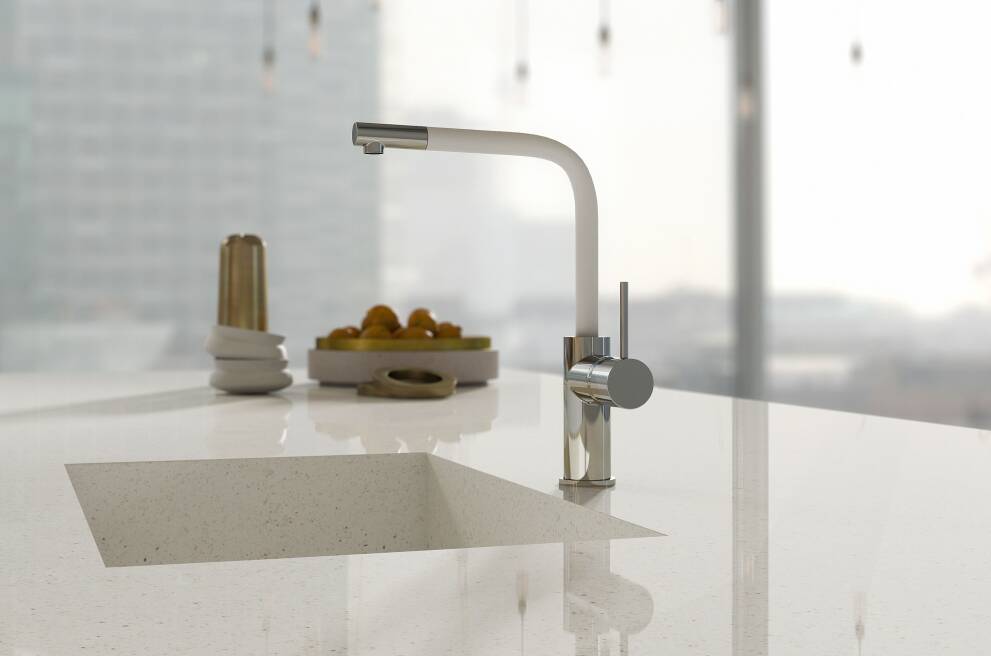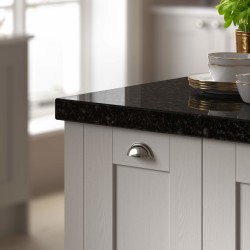Kitchen Sinks: Buying Guide
Kitchen Sinks
What is the most important appliance in your kitchen? Is it your oven? Maybe your fridge-freezer? Or is it the simple kitchen sink? While you might think a dishwasher is more useful for getting those tricky dishes clean, there’s so much more versatility that a good kitchen sink can offer you.
Not only is a kitchen sink the focal point of any kitchen, often standing out above other more inconspicuous appliances, but it’s also a vital tool for food preparation, rinsing, cleaning, and, yes, washing. Let’s face it, as brilliant an appliance as a dishwasher is, there are some things you simply have to clean in a sink; all those non-stick pots and pans and wooden-handled cutlery. So, this begs the question, which kitchen sink is the best for your kitchen.
There’s a huge range of sink types available to buy, meaning you’ll have to consider several factors before you make your purchase. Size, material, kitchen style - all these will play a role in the types of kitchen sinks that will fit your home. There’s a lot to consider, which is why we’ve put together this helpful sink buying guide in order to make the process as simple and stress-free as possible. Read on to find out how to pick the right sink for your kitchen.

Before you start
Much like when purchasing worktops or hobs for your kitchen, various considerations need to be made to ensure that whatever sink you buy is capable of fulfilling your washing and food preparation requirements. However, you also need to account for the size of your kitchen itself, and its style. The last thing you want is an aesthetic clash between a contemporary modern style kitchen and a traditional sink!
Size
If you’ve ever had to buy a new oven or kitchen cabinets, you’ll be familiar with all the different measurements you have to make in order to accommodate your new appliance. Fortunately, while you do have to measure for a sink fitting, it’s a very simple process.
There are three main steps to follow when measuring your sink space. First, you’ll need to determine if you plan on replacing your current sink with a similar design or an entirely new style. If you want a simple replacement, all you need to do is follow the first step and then find a sink replacement that matches your measurements. However, if you plan on choosing one of the other kitchen sink styles available, there are a few more steps to follow.
Begin your measurements by finding the width and length of your current sink. Unless you’re totally refurbishing your kitchen, the size of your current sink is going to roughly dictate the size of your new sink. Next, if you’re planning to buy a sink with different measurements, you’ll need to conduct the same measurements as the previous step for your kitchen worktops and cabinets. Measuring your worktops will help you get an understanding of how much usable space you’ll have to install your new sink. For your cabinets, you’ll need to measure the interior length of the cupboard space and subtract 3-4 inches (7-10cms) to account for sink mounting space.
The final measurement you’ll need to make is the depth of your current sink. As a large number of sinks are slightly dipped at the base for better drainage, you’ll need to measure from the deepest part of your sink. If you’re getting a deeper sink, you also want to ensure that it won’t obstruct anything inside the cabinet beneath.
But size isn’t just about sink measurements. You should also think about how big your kitchen actually is and where your sink can sit. For a small kitchen, you probably don’t want to buy a big sink so you can make space for an attached draining board, and it’ll let you save space for other nifty appliances like a microwave and coffee machine.
Style
The other major factor you should consider when deciding which kitchen sink to buy is style. Simply put, you need to make sure that, no matter which of the sink types you buy, it will blend in with your current kitchen aesthetic. Not all kitchen sink styles suit both a traditional kitchen as well as a contemporary interior, so you should take this into account when viewing the types of kitchen sinks available.
Of course, this isn’t as much of a problem if you plan on having a full kitchen redesign as you’ll have free rein to design your kitchen exactly how you want it.
Types of kitchen sinks
There are two main types of kitchen sinks for you to choose from when you buy a sink, each with a different mounting style. Both fulfil the same role, and neither is better than the other so your choice will ultimately come down to personal preference.

Inset
Perhaps the most common type of sink available, an inset sink is the easiest sink type to fit. Essentially, an inset sink works by slotting seamlessly into pre-cut gaps in your worktop. The edges of the sink are wider than the gap, enabling it to hang comfortably while creating a stylish lip.
Inset sinks can come in a good range of sizes and materials, most commonly stainless steel, and their design allows them to match almost all kitchen aesthetics. The majority of inset sinks also tend to come with a draining board, allowing you to store clean dishes safely while they dry.

Undermount
Undermount kitchen sinks, on the other hand, are much more suited to kitchens with a minimalist look. Their ceramic and granite models are perfect for a contemporary style, and their lack of an attached draining board also makes them suitable for smaller kitchens. Undermount sinks work by fitting the sink under your worktops, this allows it to blend in seamlessly with your kitchen cabinets, and as a bonus, the lack of lip means it's very easy to brush crumbs into.
However, you do need a solid surface such as granite or stone installed underneath to support the sink, otherwise, it’s liable to break your worktops. This makes them slightly more expensive than an inset sink. You’ll also want to choose a non-porous material to avoid damaging the kitchen cabinet beneath it.
Sink sizes
Unlike many other kitchen appliances, kitchen sink size actually refers to the number of bowls a sink comes with rather than its physical dimensions. Thus, when choosing between the types of sinks available, you should think about what you actually need from a sink. On top of this, the size of your kitchen will again play a role in your decision making. For example, a small kitchen likely only requires a sink with a single bowl.

1 sink bowl
Single bowl sinks are the standard sink option no matter what design you choose. They’re ideal for washing smaller numbers of dishes and take up minimal space, so they naturally go well with tight spaces. If you use a dishwasher, a 1 bowl sink is the perfect companion to wash up all the bits that can’t go in.
1.5 sink bowl
A 1.5 bowl model differs very slightly from a single bowl sink. While your primary sink will be the same size as a single bowl design, you also get another smaller bowl attached to the side. This additional bowl takes up minimal extra room while giving you another tool for rinsing, food preparation, and waste disposal, especially when the main bowl is full.
2 sink bowls
Lastly, you can double the size of your sink by purchasing a 2 bowl design. Having two bowls takes all the benefits of a 1.5 bowl and gives you more space. They’re particularly useful if you cater for large groups of people on a regular basis, allowing you to soak dirty dishes in one bowl while washing dishes or preparing food in the other.

Choose your sink shape
Nowadays, people don’t typically think about the various shapes of sinks available. Rectangular or square designs are most common as they offer more room to clean large objects, but circular sinks can offer a retro feel while fitting into smaller spaces. There are, however, two other popular sink shapes you could consider.
The first of these is the Belfast sink. These sinks have a shape akin to a bathroom basin, making them fairly deep, with the front of the sink jutting out from the worktops. Rustic and popular with farmhouse and Shaker style kitchens, they’re often made of ceramic and sit directly atop a kitchen cabinet.
The second option is a butler sink. Almost exactly the same shape and material as a Belfast sink, a butler sink is slightly shallower and lacks an overflow to encourage water conservation, allowing you to be more environmentally friendly.
Sink materials
One of the more important aspects you should think about when deciding which kitchen sink to put in your kitchen, you should look for a material that both complements your kitchen’s aesthetic and can handle exposure to a variety of contaminants.
The most common materials used tend to be either stainless steel or ceramic, but you can find many kitchen sink styles that use stone or resin composites for a fresher look. Each material has its benefits and drawbacks with regards to cleaning, durability, and general wear and tear resistance, so it’ll be up to you to pick the best material for your needs.
Stainless steel
Stainless steel is an incredibly popular choice within many kitchens, being particularly well suited for contemporary kitchens while easily being matched with other similar styled appliances.
It’s a highly durable material that’s very easy to clean, but it’s also less scratch-resistant than other materials. Stainless steel can also eventually dull from persistent staining, requiring you to clean it with specific tools.
Ceramic
If you want a more traditional kitchen sink material, ceramic offers a classic feel while being incredibly versatile in its application. Ceramic is great for use in kitchens with contrasting colours and conventional cabinet fittings while offering the same durability as stainless steel. It’s also very easy to clean but has the added benefit of being heat, stain, scratch, and chemical resistant as well as possessing anti-bacterial properties.
Unfortunately, all of these bonuses make ceramic sinks more expensive than their stainless steel counterpart, and if your sink cracks or chips, there’s no easy way to repair it.
Composite quartz/granite
To give your sink a more exotic feel, you might want to opt for a quartz or granite composite. This material is formed through binding stone elements with a super tough resin to replicate the natural stone for a hard-wearing, long-lasting appliance.
While limited to stone themes, quartz and granite composites still offer a range of colour and size versatility. Not only that, but any composite is super resistant to heat and scratching, as well as having an antibacterial coating thanks to the resin. Much like ceramic, however, these composites can be expensive.
Resin
Resin composites, such as Corian, differ slightly from their granite composite cousins. Rather than stone, these composites use natural materials and bind them with a resin to produce a substance similar to plastic but much tougher. This allows resin sinks to be a single uninterrupted piece that is scratch, stain, and heat resistant.
That being said, resin sinks have one major drawback. The resin used is naturally waterproof, but should the resin get damaged, and water gets inside, it can affect the integrity of the sink. This damage is very difficult to repair, meaning you need to be careful to avoid damaging them.

Sink finishes and colours
Naturally, certain types of sinks are going to be limited by their material’s style. But that doesn’t mean you won’t be able to find a range of good style and finish options. Ceramics and resins can be designed to provide a mirror or matt effect, depending on how you want it to blend with your kitchen. Or you can opt for a brush effect on metal sinks.
If you want a sink in a specific colour, there tend to be four popular choices. A black sink offers a striking and contemporary look, its dark tones enabling it to mask stains and marks. White, on the other hand, provides a sense of cleanliness, being a versatile choice that fits many kitchen aesthetics. It brightens a room and makes it feel more open and inviting.
You might also want to opt for a silver, which trends towards offering a more professional style, but one that can fit both contemporary and classic kitchens. And lastly, grey is a brilliant neutral palette that’s good for subtlety and sophistication while softening dark colours.

Kitchen sink accessories
Of course, no kitchen sink is complete without additional accessories. While not as numerous as those you’d find on a fridge or oven, what kitchen sink accessories there are can be useful additions to invest in when you buy a sink.
Waste disposal unit
When you buy kitchen sink accessories, your mind might not even consider the addition of a waste disposal unit. Applicable if you have more than one bowl, these grinders are integrated into your smaller sink’s plug hole and are activated by flicking a switch.
To grind up waste food, you simply pour water in alongside the waste, which is ground into fine particles without the use of knives or blades, before being deposited in the wastewater pipe. A waste disposal unit is great for convenience and hygiene.
Kitchen taps
Obviously, the other major sink accessory you’ll need to think about is your choice of kitchen taps. There are many types of kitchen taps available, too many to go through here, but you can read all about them in our tap buyer’s guide.

Where to buy kitchen sinks?
You can find a variety of sink types available in all major kitchen retailers, typically offering a wide range of materials and finish options. When you buy with Wren Kitchens, we can provide all the material options mentioned in this guide and help you install your sink. Alternatively, we can help you with a full kitchen refurbishment, meaning you’ll have no trouble designing your perfect kitchen.
At Wren Kitchens, our kitchen experts have decades of experience, letting them help anyone pick and choose the ideal sink for their kitchen. Why not book an appointment at your local showroom today and have a chat with one of our friendly kitchen experts? We can help you with every stage and step when it comes to building your dream kitchen.
If you’re only after a small sink and want a dishwasher to make cleaning up after dinner a breeze, you can read our dishwasher buyer’s guide right here. For even more help, you can check out the rest of our kitchen and appliance buying guides or head over to our inspiration section for more great ideas.


















